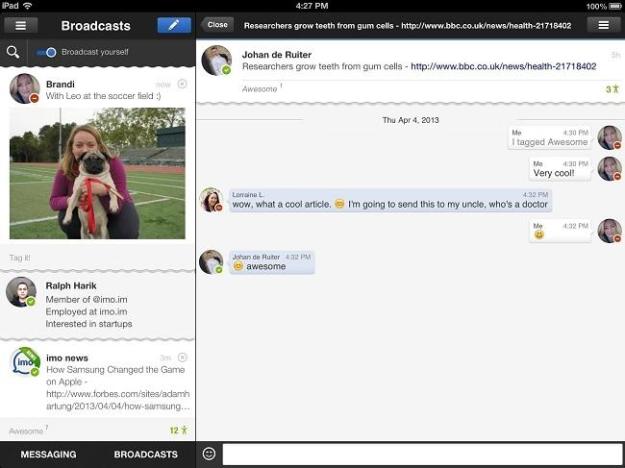
Hitting the social market is a natural progression for messaging apps. We’ve witnessed with major messaging apps like LINE, WhatsApp, and Tango, while making a point about these very real threats to Facebook (and how Facebook has been trying to do the same thing … just in reverse). Now there’s officially another contender in Imo.im’s (Imo, for those familiar) Broadcasts.
We’ve played around with Broadcasts since the feature was first made available to select users during beta testing and couldn’t help but notice how closely it resembles Facebook’s News Feed. Photo-sharing, sharing news, and status updates are all core capabilities in the Broadcasts update, which rolls out to out to Android and iOS devices starting today. More importantly, Broadcasts is meant for people discovery. You’ll find status updates, news, and other information showing up on the page from people you don’t actually know nor have connected with.
People discovery is something Imo has been working on since its original launch. Currently, the app has seven million mobile downloads and 750,000 unique users daily, so it’s becoming more and more important you’re able to find the people you want to talk to. Broadcasts has been in development since 2011 and an early version was released in 2012, which replaced (and renamed) its first version of a people discovery feature named “Meet New People.” But it’s not until today that Broadcasts was ported to mobile.

Imo takes a slightly different approach to its take on the news feed than its mobile messaging competitors and social networks like Facebook and Twitter. Imo’s Broadcasts surfaces status updates and news from within its network of users, but these users are people you’ve never met before nor haven’t chosen to follow. You won’t recognize the people and the content that shows up on Broadcasts, but that’s part of the fun. Imo expects its users to comment, and connect with people the app thinks you’ll get along with. Private messaging is already working well within the app, and it appears the push to find new friends is a part of Imo’s attempt to get more social and encourage users to expand their Imo-based networks.
“There are billions of people in the world, and right now you only get to interact, learn, and spend time with a few of them. There’s a lot to be gained from people outside your immediate network, and people are often the best resources for learning and navigating the world. We’re going to try to make that resource available to people to enrich their lives,” Imo.im co-founder Georges Harik says.
The app does this by tapping into a proprietary algorithm, which identifies your interests based on your friends, location, and what you engage with and what you share on the Imo network. It then bubbles up the people that best match your own interests. You’ll find the user’s bio, status updates, photos, interests, and other details that hopefully convince you to make them part of your own network.
At first look, you’ll find that few if any people appear to relate to you, but it takes time for the algorithm to create a clear interest graph about you to suggest similar people via Broadcasts.
The problem is that to avoid being spammed by strangers, Imo limits the number of messages or calls you can send by limiting the number of “Communication Points” that you can own. Think of this like Imo credit that you can spend to message people, or like the $7 you’d have to spend to message someone outside of your immediate network of Facebook friends. The idea sort of counteracts the purpose of messaging or getting to know compete strangers, but fortunately Communication Points are refreshed daily.
“We want users to find relevant and useful information, people, news and other content that will make their lives better. Imo Broadcasts is a platform to achieve that,” Imo.im CEO Ralph Harik says.
It’s all a rather risky move: Most apps trying to experiment with the messaging-meets-private-social-network market are focusing on the very thing that gives them a leg up on larger platforms like Facebook: Your information stays within a tight social circle; it’s all socializing chatting between the people you’re normally talking to anyway. So Imo’s tactic is a little unprecedented.
Imo has been undergoing rapid changes in the last year, as the habits of communication app users have rapidly shifted thanks to LINE, WeChat, Nimbuzz, KakaoTalk and other apps. Imo launched a redesigned user interface for Android, iPhone, and iPad, and launched voice-calling to enable free VoIP voice calls over 3G/4G data plans or a WiFi connection user-to-user.
